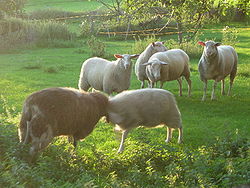
East Friesian
Encyclopedia

Dairy
A dairy is a business enterprise established for the harvesting of animal milk—mostly from cows or goats, but also from buffalo, sheep, horses or camels —for human consumption. A dairy is typically located on a dedicated dairy farm or section of a multi-purpose farm that is concerned...
sheep originating from East Frisia
East Frisia
East Frisia or Eastern Friesland is a coastal region in the northwest of the German federal state of Lower Saxony....
in northern Germany. It is either the best or one of the best sheep breeds in terms of milk yield per ewe.
The East Friesian produces roughly 300-600 liters of milk, over a 200- to 300-day lactation
Lactation
Lactation describes the secretion of milk from the mammary glands and the period of time that a mother lactates to feed her young. The process occurs in all female mammals, however it predates mammals. In humans the process of feeding milk is called breastfeeding or nursing...
. There are reports of individual animals with milk yield reaching 900 litres. That's counting the milk suckled by the lambs as well as milking by machine. In order to provide a high milk-yield, the ewe must receive a high-quality diet.
Another attraction of the breed is a relatively high average number of lambs born per ewe.
East Friesians are used as either a purebred milking breed or as a crossing breed for other milking sheep. They can raise the average number of lambs born, as well as milk production, when crossed with other milk sheep breeds. They are not a very hardy or adaptable breed, but their cross-breeds can be. Crossing them with the Awassi
Awassi
The Awassi is a local sheep breed in South-West Asia originated in the Syro-Arabian desert. Other local names can also be Ivesi, Baladi, Deiri, Syrian, Ausi, Nuami or Gezirieh. It is a fat-tailed type and is multi coloured: white with brown head and legs . The ears are long and drooping...
breed has been a notable success in Mediterranean or semi-arid environments. East Friesians crossed with the Lacaune
Lacaune (sheep)
The Lacaune is a breed of domestic sheep originating near Lacaune in southern France. The Lacaune is the most widely used dairying sheep breed in France, with a population of about 800,000 ewes...
breed have been a success in the Wisconsin
Wisconsin
Wisconsin is a U.S. state located in the north-central United States and is part of the Midwest. It is bordered by Minnesota to the west, Iowa to the southwest, Illinois to the south, Lake Michigan to the east, Michigan to the northeast, and Lake Superior to the north. Wisconsin's capital is...
environment. It was not until the 1990s that East Friesians were introduced into North America. But since then, on account of their high milk yield, they've rapidly become the breed of choice among commercial sheep milk producers, although generally not in purebred form.
The Friesian sheep breeds are a heathland type sheep, the land environment in much of Frisia. The group includes related dairy breeds taking their names from, and probably largely originating in, West Friesland
West Friesland (historical region)
West Friesland is a historical region in the northern part of the Netherlands. It was located in parts of what now is Noord-Holland and the Waddenzee. The region was bordered by the rivers Vlie and IJ...
and Zeeland
Zeeland
Zeeland , also called Zealand in English, is the westernmost province of the Netherlands. The province, located in the south-west of the country, consists of a number of islands and a strip bordering Belgium. Its capital is Middelburg. With a population of about 380,000, its area is about...
. Historically the sheep were kept in small numbers by households for household milk. Today reportedly these sheep do poorly when in large dense flocks.
In physical appearance the East Friesians have pink noses and their head and legs are clear of wool
Wool
Wool is the textile fiber obtained from sheep and certain other animals, including cashmere from goats, mohair from goats, qiviut from muskoxen, vicuña, alpaca, camel from animals in the camel family, and angora from rabbits....
. Their heads are naturally polled
Polled livestock
Polled livestock are livestock without horns, of species that normally have them. The term refers both to breeds or strains which are naturally polled through selective breeding and also to naturally horned animals which have been dehorned...
, i.e. hornless. They generally have pale hooves. The most distinctive feature of an East Friesian is its tail, which is described as a "rat-tail" because it is thin and free of wool. Elsewhere on their bodies they have white wool which is approximately 35-37 micrometres
Micron (wool)
A micron is the measurement used to express the diameter of a wool fibre. The lower microns are the finer fibres. Fibre diameter is the most important characteristic of wool in determining its greasy value....
, with a staple
Staple (textiles)
A Wool Staple is a naturally formed cluster or lock of wool fibres and not a single fibre. Very many staples together form a fleece.* Image of the staples on the sheep The cluster of wool fibres is made by a cluster of follicles...
length of 120–160 millimeters and their fleece
Wool
Wool is the textile fiber obtained from sheep and certain other animals, including cashmere from goats, mohair from goats, qiviut from muskoxen, vicuña, alpaca, camel from animals in the camel family, and angora from rabbits....
ranges from 4–5 kg (8.8–11 lb).

